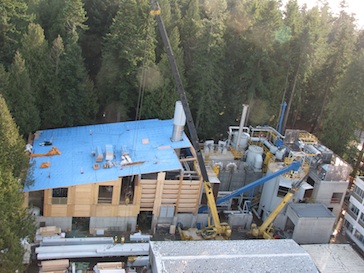
New Nexterra projects include biomass CHP
May 14, 2012
By
Scott Jamieson
 May 14, 2012, Vancouver - Nexterra Systems
Corp. is poised to significantly expand its fleet of biomass energy systems as
it officially opens two large new projects at the US Department of Energy’s Oak
Ridge National Laboratory (ORNL) in Tennessee and at UBC in Vancouver.
May 14, 2012, Vancouver - Nexterra Systems
Corp. is poised to significantly expand its fleet of biomass energy systems as
it officially opens two large new projects at the US Department of Energy’s Oak
Ridge National Laboratory (ORNL) in Tennessee and at UBC in Vancouver.
The new
projects build on previous energy systems in British Columbia, including those at
UNBC, Kruger’s New Westminster paper mill, the Dockside Green residential
development in Victoria, and Tolko’s plywood mill in Kamloops. Another plant is
currently under construction at a Veterans Affairs Medical Centre in Michigan.
Working with US multinational Johnson Controls, Inc., Nexterra recently
completed its largest project to date – a 21 MWt (60 MMBtu/hr) gasification
system at ORNL, the DOE’s largest science and energy laboratory. ORNL’s system,
about four times the capacity of UNBC’s plant, converts locally sourced wood
residue into syngas and provides 60,000 lbs/hr of low-pressure steam to heat
the facility. It will enable ORNL to decrease its reliance on fossil fuels and
reduce greenhouse gas emissions by 20,000 tons/yr, equivalent to taking 4,500
cars/yr off the road.
Up and running since January, the ORNL system has met all performance
tests, and produced exceptionally low air emissions, much cleaner than
conventional wood combustion and equivalent to natural gas. The official
opening is scheduled for late June.
Next to open is Nexterra’s bioenergy project at UBC. The plant will demonstrate
at commercial scale a new renewable combined heat and power (CHP) solution that
combines Nexterra’s gasification and unique new syngas conditioning
technologies with General Electric’s Jenbacher internal combustion engine.
This full-scale commercial demonstration follows development of the
syngas cleanup and conditioning train of equipment at Nexterra’s product
development centre in Kamloops. Over 5,000 hours of testing were completed on
the system, with over 3,000 hours of run time on a GE Jenbacher engine. Gas
stability, syngas quality, engine cleanliness and output all meet and exceed
the syngas fuel specifications for GE Jenbacher engines.
Nexterra says the resulting power system will be
significantly more efficient, cost-competitive and cleaner than conventional
biomass combustion-to-steam or combustion-to-ORC power plants. This will make
the system economically viable at a scale of 2 to 10 MWe – one-tenth the size
of conventional biomass-to-steam power systems.
The $27 million UBC project requires 12,500 metric tonnes of
locally sourced urban wood waste per year, averaging two to three trucks per
day. Creating 2 MWe and 9,600 lbs/hr of steam from
renewable biomass, the process will significantly reduce UBC’s annual carbon
footprint, equivalent to taking 1,000 cars off the road. Scheduled
to open in early fall, this plant be the first commercial demonstration of
this system in the world.
Print this page